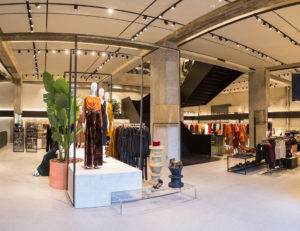From RFID sensors to beacons to digital kiosks and signs, IoT in retail is everywhere. Much of the discussion around the Internet of Things (IoT) in retail is about how it will change the customer experience. However, you can also leverage IoT devices as tools to benefit your employees. Smart fitting rooms represent one way that IoT is changing the retail experience for both customers and store associates.
The Mango Story—Smart Fitting Rooms Keep Employees and Customers Connected
Last year, fashion retailer Mango invested 2.6 million euros in a massive flagship store in Lisbon, Portugal’s capital, in a prime location in Plaza dos Restauradores (think Rodeo Drive or Herald Square). Housed in the iconic Eden Theater building, built in 1931, architects designed the store to be a single, open space to engage customers and improve their experience.

Their flagship store, among many others, is technologically enhanced with Wi-Fi, a dedicated zone for Click & Collect, and smart fitting rooms. These fitting rooms feature a smart mirror, designed by Mango and developed by Vodafone in collaboration with Spanish smart systems and IoT specialists, JogoTech.

Mango, like most fashion retailers, found that fitting rooms were something of a black hole for employees. Dedicated fitting room associates had to hover near each fitting room stall in case shoppers needed them to run to the floor and retrieve a different size or color to try on. During peak hours, the number of shoppers outnumber fitting room attendants. Figuring out which customers to prioritize was a challenge.
In Mango’s new smart fitting rooms, associates scan the clothing that shoppers bring in, using barcodes or RFID. Mango team members can communicate quickly and seamlessly with shoppers via the newly installed smart mirrors, which shoppers use to contact Mango floor staff for different sizes, colors, or additional items.
Fitting rooms are a prime area where conversions are made. Smart fitting rooms help the team at Mango drive these conversions in a much smoother and efficient way, with customers getting the attention they need.
Inside Ralph Lauren’s Smart Fitting Rooms
Ralph Lauren is another fashion brand leveraging IoT via smart fitting rooms. They installed connected fitting rooms in their Fifth Avenue flagship store in Manhattan, developed by Oak Labs. According to Digiday, the store saw a 90% engagement rate in just five months—which blew expectations out of the water.
Ralph Lauren’s smart fitting rooms work much the same as Mango’s with RFID scanning to recognize the items. These mirrors offer the customer information on additional sizes and colors in stock as well as complementary items. When a customer needs an employee, they simply hit the “Call an Associate” button. Before they had such technology, the fitting room attendant would have to listen for a shout or question, a frustrating way for all parties to communicate.
These smart fitting rooms place Ralph Lauren above its luxury counterparts, being recognized as the retailer most successfully integrating technology into stores. These fitting rooms represent a competitive edge, but it’s not just the employee experience—it makes the employees who work the fitting rooms, too.
The connection between associate and customers isn’t broken when they go into the dressing room. They can communicate when needed, instead of sales associates trying to guess who needs help.
Additionally, these mirrors are collecting real data about what goes into the dressing room and what makes it into a shopper’s bag. This data offers a wealth of knowledge to employees, as it could help them push certain products because they are performing well.
Employees at Ralph Lauren use the RFID technology internally to find items or check stock numbers. The mirrors pull up not only what the item is but where it is in the store and how many. This saves valuable time that would otherwise feel like a scavenger hunt.
Ralph Lauren has been successful in its leverage of IoT, making the customer and employee experience better. Employees now have a tool to help manage customer needs and improve their overall workflow.
Putting It All Together—How to Leverage IoT with POS Data
Smart fitting rooms are one way to make life easier for retail sales associates. When you combine the power of IoT with an in-depth analysis of your POS data, you could learn even more to help employees. This could include using data to guide merchandising changes, staffing levels, or new strategies for sales associates to close more sales.
You can read more about other ways to use technology to help your operations teams on our blog. Check out how Walmart increased engagement and made it easier to learn by using VR goggles to train new hires. CB4 makes it easier for store operations teams to find and fix operational issues with our artificial intelligence tool. Click here to learn more.

